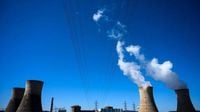On Monday, October 20, 2025, the National Nuclear Security Administration (NNSA)—the federal agency tasked with safeguarding America’s nuclear arsenal—was thrown into turmoil as the Trump administration ordered an unprecedented mass furlough of its workforce. According to reports from Politico and confirmed by Department of Energy officials, about 1,400 federal employees at the NNSA received furlough notices, leaving just 375 to 400 staff members on duty to protect property and human safety. This dramatic reduction in staffing comes as the U.S. government shutdown entered its 20th day, marking the longest full federal closure in the nation’s history.
The NNSA, a semiautonomous agency within the Department of Energy, plays a critical role in maintaining the United States’ nuclear stockpile, responding to nuclear emergencies both at home and abroad, and working to prevent nuclear proliferation worldwide. With fewer than 2,000 federal workers overseeing a vast network of approximately 60,000 contractors, the agency’s responsibilities are immense. The NNSA manages the U.S. nuclear arsenal, which currently consists of 5,177 warheads—1,770 of which are actively deployed. The initial wave of furloughs is expected to impact nuclear assembly sites such as Pantex in Texas and Y-12 in Tennessee, raising fresh concerns about the nation’s ability to maintain and secure its most dangerous weapons.
Energy Secretary Chris Wright, speaking last week before the furlough notices were issued, emphasized the vital importance of the NNSA workforce. “These workers are critical to modernizing our nuclear arsenal,” Wright stated, underscoring the agency’s ongoing efforts to update and maintain the reliability of the U.S. deterrent. Yet, despite these warnings, the Trump administration pressed forward with the furloughs after another congressional vote to end the shutdown failed on Monday morning. As reported by Politico, this is the first time in the NNSA’s 25-year history that such sweeping furloughs have been implemented during a budget lapse.
The political stalemate in Washington has only deepened the crisis. President Donald Trump has repeatedly called on Democrats to cooperate with Republicans to reopen the government, warning of even deeper service cuts and widespread layoffs if the impasse continues. “Due to the Democrat shutdown, approximately 1,400 NNSA federal employees will be furloughed as of today, October 20th, and nearly 400 NNSA federal employees will continue to work to support the protection of property and the safety of human life,” a Department of Energy spokesperson said in a statement, as cited by Politico and other outlets. White House economic adviser Kevin Hassett projected that the shutdown could end “some time this week,” but also hinted that stronger measures might be necessary if negotiations remain stalled.
The core of the dispute centers on health care subsidies. Democrats have insisted that any deal to reopen the government must include the renewal of expiring health care subsidies for 24 million Americans. Senate Republicans, for their part, have offered a vote on the issue, but Democrats remain firm that any agreement would be ineffective without the explicit backing of President Trump and House Speaker Mike Johnson. Monday’s Senate vote to reopen the government failed for the 11th time, leaving federal employees in limbo and the nation’s nuclear security apparatus running on a skeleton crew.
The effects of the shutdown are being felt far beyond the NNSA. Federal employees across the country are bracing for their first missed full biweekly paychecks, which are due on Thursday, October 23. The situation is especially dire for military personnel and workers at critical infrastructure sites. House Minority Leader Hakeem Jeffries warned that if the shutdown continues, health insurance premiums in states such as Georgia, Virginia, and Maryland could skyrocket by as much as $24,000 per year for some Americans in 2026.
Rep. Dina Titus has emerged as one of the most vocal critics of the administration’s decision to furlough NNSA employees. “This puts our national security at risk,” Titus declared, arguing that the employees being sidelined are essential for managing the U.S. nuclear stockpile. She warned that halting their work would weaken the nation’s deterrence, and while there is currently no immediate threat, the lengthy shutdown could delay vital modernization efforts and raise serious questions about the future reliability of the U.S. arsenal. Titus also accused President Trump of using the furloughs for political gain, claiming the decision “jeopardizes national security for political gains.”
The current furloughs come on the heels of previous staffing controversies at the NNSA. Earlier in the year, the agency faced scrutiny for terminating hundreds of workers at the behest of President Trump’s Department of Government Efficiency. Energy Secretary Wright later admitted that mistakes had been made and that the agency had “moved a little too quickly,” leading to a scramble to rehire some of the dismissed employees. The repeated disruptions have left many questioning the stability and long-term effectiveness of the agency tasked with overseeing the nation’s most sensitive weapons systems.
While the Department of Energy has assured the public that the remaining staff will focus on protecting property and human life, experts and lawmakers alike remain uneasy. The furloughs have never before been implemented at this scale during a budget lapse in the NNSA’s history, and the risks associated with a prolonged shutdown are difficult to quantify. Delays in modernization, maintenance, and security operations could have cascading effects, potentially undermining both national security and international confidence in the U.S. nuclear deterrent.
As the government shutdown drags on with no immediate end in sight, the fate of the NNSA and the safety of the nation’s nuclear arsenal hang in the balance. The coming days will test not only the resolve of lawmakers in Washington but also the resilience of the agencies and workers who shoulder the grave responsibility of protecting America’s most powerful weapons.





